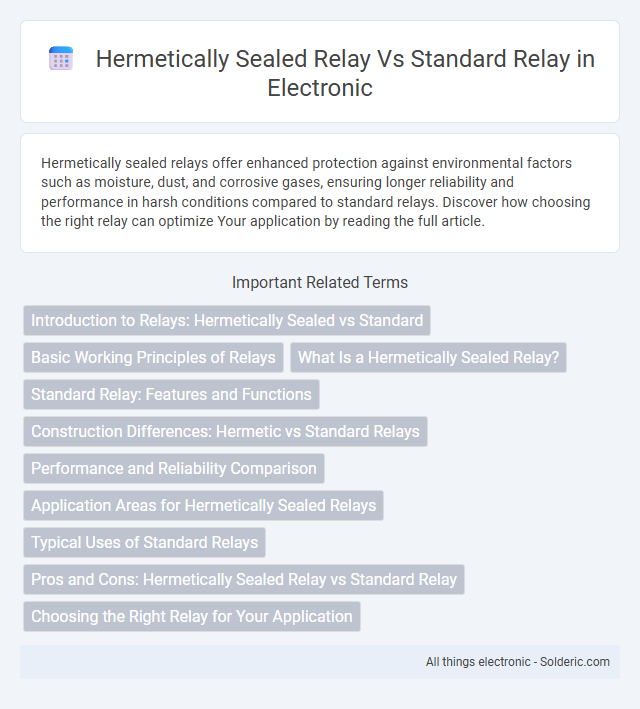Hermetically sealed relays offer enhanced protection against environmental factors such as moisture, dust, and corrosive gases, ensuring longer reliability and performance in harsh conditions compared to standard relays. Discover how choosing the right relay can optimize Your application by reading the full article.
Comparison Table
| Feature | Hermetically Sealed Relay | Standard Relay |
|---|---|---|
| Sealing | Gas-tight metal or glass enclosure, prevents contamination | Open or plastic housing, prone to dust and moisture ingress |
| Reliability | High reliability in harsh environments | Moderate reliability, affected by environment |
| Applications | Medical, aerospace, military, industrial automation | General-purpose electronics, automotive, consumer devices |
| Lifespan | Longer lifespan due to protection against corrosion and oxidation | Shorter lifespan, more maintenance required |
| Cost | Higher cost due to specialized sealing | Lower cost, mass-produced |
| Size and Weight | Generally compact but can be heavier due to enclosure | Varies, often lighter and smaller |
Introduction to Relays: Hermetically Sealed vs Standard
Hermetically sealed relays provide airtight protection, preventing moisture, dust, and contaminants from entering and ensuring enhanced reliability and longevity compared to standard relays. Standard relays, while more common and cost-effective, lack this specialized sealing, making them more susceptible to environmental factors that can cause premature failure. Your choice between these relays depends on the application environment and the criticality of maintaining consistent performance under harsh conditions.
Basic Working Principles of Relays
Hermetically sealed relays operate by enclosing their contacts and coil in a vacuum or inert gas-filled case to prevent contamination and corrosion, ensuring reliable switching in harsh environments. Standard relays function by using an electromagnetic coil to open or close electrical contacts exposed to the atmosphere, which can be susceptible to dust, moisture, and oxidation over time. Your choice between these relays depends on the need for durability and environmental protection versus standard operational settings.
What Is a Hermetically Sealed Relay?
A hermetically sealed relay features an airtight enclosure that protects its internal components from environmental contaminants such as dust, moisture, and corrosive gases, ensuring enhanced reliability and longevity in harsh conditions. Unlike standard relays, which typically have exposed contacts and are susceptible to oxidation and debris, hermetically sealed relays maintain stable performance in critical applications like aerospace, medical devices, and industrial automation. This sealed environment also prevents contact degradation, resulting in consistent electrical characteristics and reduced maintenance requirements.
Standard Relay: Features and Functions
Standard relays feature electromagnetic coils that control contacts to open or close electrical circuits, offering reliable switching for various applications. These relays typically handle moderate current and voltage levels, making them suitable for general-purpose use in automotive, industrial, and home automation systems. Your choice should consider factors like contact rating, coil voltage, switching speed, and environmental exposure to ensure optimal performance.
Construction Differences: Hermetic vs Standard Relays
Hermetically sealed relays feature an airtight enclosure, typically made of metal or glass, preventing moisture, dust, and contaminants from entering and ensuring long-term reliability in harsh environments. Standard relays often use plastic or non-sealed housings, allowing exposure to external elements, which can degrade performance over time. The hermetic seal enhances durability and stability, making these relays suitable for aerospace, medical, and industrial applications requiring stringent environmental protection.
Performance and Reliability Comparison
Hermetically sealed relays offer superior performance and reliability compared to standard relays by providing a fully enclosed environment that protects internal components from moisture, dust, and contaminants, reducing the risk of corrosion and failure. This sealed design ensures consistent electrical contact and extended service life, making them ideal for critical applications requiring high durability and minimal maintenance. Your system benefits from enhanced operational stability and lower downtime when using hermetically sealed relays over standard relays.
Application Areas for Hermetically Sealed Relays
Hermetically sealed relays are ideal for applications requiring protection against moisture, dust, and corrosive environments, such as aerospace, medical devices, and military equipment. Their airtight enclosure ensures reliable performance in extreme conditions like temperature fluctuations, vibration, and exposure to chemicals. Using these relays in your critical systems enhances durability and longevity compared to standard relays.
Typical Uses of Standard Relays
Standard relays are commonly used in automotive applications, home appliances, and industrial control systems due to their cost-effectiveness and versatility. They typically handle moderate voltage and current loads, making them suitable for switching signals and controlling motors or lights in standard environments. Your choice to use a standard relay depends on the need for reliable switching without the requirement for extreme environmental protection.
Pros and Cons: Hermetically Sealed Relay vs Standard Relay
Hermetically sealed relays offer superior protection against environmental factors such as moisture, dust, and corrosive gases, ensuring higher reliability and longer lifespan compared to standard relays. Standard relays provide cost-effective solutions and simpler maintenance but are more susceptible to contamination and mechanical wear, leading to potential operational failures in harsh conditions. The trade-off between enhanced durability and higher initial cost distinguishes hermetically sealed relays from standard relays in industrial and critical applications.
Choosing the Right Relay for Your Application
Hermetically sealed relays offer superior protection against moisture, dust, and corrosive environments, making them ideal for aerospace, medical, and military applications where reliability is critical. Standard relays, while cost-effective and suitable for general use, lack this stringent sealing and may not perform well under harsh conditions. Evaluate your application's environmental challenges and reliability requirements to choose the relay that ensures optimal performance and longevity.
Hermetically Sealed Relay vs Standard Relay Infographic

 solderic.com
solderic.com